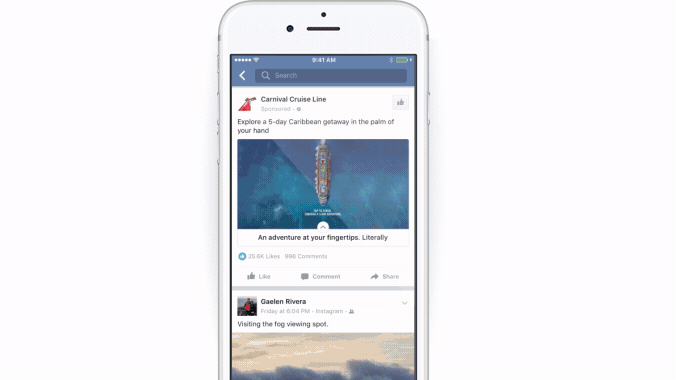Facebook: Five reasons why you should use Canvas!
Facebook: Five reasons why you should use Canvas
Live my life of…Blaise, General Director of Interface Tourism France
7 July 2017Bloggers: should we give up group trips for individual trips?
23 August 2017Facebook: Five reasons why you should use Canvas

With the accession of mobile and the growth of digital advertising investments, it is now essential for a brand or a destination to integrate mobile advertising (especially on social media) into its communication strategy. There is a multitude of advertising formats on social media: a simple sponsored post, a carousel, a page likes campaign, a video, etc. It may seem difficult to make a choice according to its objectives and budget. Today, we want to talk to you about the Facebook Canvas format.
Before revealing you the reasons why you absolutely have to use this advertising format in your next social media strategies, we are going to begin with defining what Canvas is and what is its use.
Launched in 2016, Canvas was the innovative mobile advertising format developed exclusively on mobile in response to the growing number of users (1,936 billion monthly users of the Facebook mobile application in June 2017). The principle is simple: an optimized full-screen experience which starts after the user has clicked on a publication or an ad.
This advertising format initially was developed to highlight a brand’s storytelling, – a perfect feature to tell a story in a more engaging, immersive and original way, and to catch the user’s attention, create emotions, and thus develop the engagement of a Facebook page.
1. Catch consumers’ attention
The average viewing time of a Canvas is approximately 30 seconds – and up to 70 seconds for the most creative ones, way higher than ordinary mobile ads. This success is linked to the possibility of integrating videos (including 360°), carousels, panoramic photos, links and call-to-actions. It is well known that on the Internet an image is better than a text, because it is more efficient to convey an emotion or a message and thus to capture the attention of the consumer. This format is ideal for promoting a destination and responding to the expectations of tourism stakeholders: travel-related content will attract the user who will then be more likely to do the action you want them to (sharing a post to improve online visibility, a click to your website, or discover more about a territory or an offer, etc.).

2. Intuitive navigation and fast loading
The navigation is also very simple and intuitive: once the advertisement is open on their screen, the user can scroll the contents, zoom in to see the images in detail, go back, etc. Moreover, Facebook Canvas guarantees very short loading times – up to 10 times faster than traditional mobile advertising thanks to the capacity of the social network to host all the content itself. Canvas is also compatible with iOS and Android environments.
3. Choose your goal and targeting
The Canvas format was originally developed to highlight the values and the history of a brand in order to increase the engagement. Only a few months ago, Facebook decided to go even further and offer this advertising tool to meet the new expectations of advertisers and achieve different objectives: traffic acquisition, online conversion, page likes campaign … Canvas has the same targeting options as other Facebook ads, so it is possible to create real experiences directed to the right audience in just a few clicks.
4. Fully customizable
It is very easy to design a Canvas from start to finish through the Facebook Ads manager. You can choose between the different templates proposed by the social network depending on the objectives of the campaign and to integrate the contents (images, videos, texts, products, etc.). These models are completely customizable and ready to use. There is also “Creative Hub”, an online platform dedicated to the creation of Facebook ads, but which focuses mainly on mobile ads. Many examples of ads are available in all formats for Facebook and Instagram – a real inspiration for creatives and advertisers!
5. An attractive cost
The advantage of the Canvas format is also its price – the cost per objective is very interesting. This is the case for CPC (cost-per-click) which can amount to € 1.50 according to the markets via the display, while on Facebook, the CPC can reach € 0.11 to reach the same result. Just like any other ad format, the Canvas can be adapted to any budget. You choose the amount of your campaign, the target criteria and the duration of the operation.
It is for all these reasons that we have included the Canvas format into our social media strategy for the Cap Cotentin Tourism Board in order to highlight the unique aspects of the territory. Here is an example:

As you can well imagine, the most complicated task is not to create a Canvas, but to think about the different contents that you want to integrate. Once this step is over, the rest is just a breeze. It’s time to get started – be creative, we’re looking forward to seeing the results!

 Toutes les news
Toutes les news  Retour à la newsroom
Retour à la newsroom


